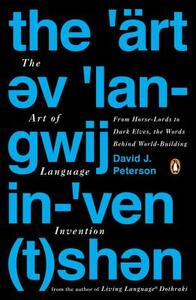Take a photo of a barcode or cover
200 reviews for:
The Art of Language Invention: From Horse-Lords to Dark Elves, the Words Behind World-Building
David J. Peterson
200 reviews for:
The Art of Language Invention: From Horse-Lords to Dark Elves, the Words Behind World-Building
David J. Peterson
challenging
funny
informative
inspiring
medium-paced
challenging
informative
inspiring
reflective
medium-paced
informative
slow-paced
Definitely more of a signpost than a guide, but with some drawbacks as a 'signpost' - it does identify some of the key things to consider in developing a language but lacks a sort of simple list (exhaustive or otherwise) or references to other useful sources for developing a more detailed understanding. I also think it would have been nice for the UK edition of the book to include standard British English examples when explaining phonics rather than standard American English (as my AE accent is very bad at the best of times, these references were rather unuseful without having to google the pronunciation of every word).
The section on creating fonts (for typing) went a bit over my head, but one thing that stood out was the lack of recommendations for useful software. The section on grammaticalisation also mentioned that many books on the subject exist but didn't name or suggest a single one. There was also a whole section on language evaluation but nowhere was there a suggested approach to create proto-languages and evolve them or anything else. This works as an inspiration and a 'heads up look out for this' but cannot function as a practical guide in any way on the actual creation process - more useful to refer to when approaching a part of the process covered in the book (as a starting point... alone it is not sufficient for this either).
The case studies were sometimes interesting but probably of more interest to someone with knowledge of the languages referenced/the shows they come from. Peterson has a pretty funny writing style (obviously intentionally) and some (like his references to onions being bad - a controversial opinion) are hilarious, although some did go over my head as I didn't understand the pop references being made (not consuming a lot of American TV will do that).
Overall, a book I'll definitely be referring to again in the future... but I need to go and watch a ton of YouTube videos (and read a lot of Wikipedia pages) to be able to start using it.
I will also say... some of the explanations are such that someone without any prior linguistic knowledge would lose track of what's going on VERY quickly. Just a warning. You don't need to be an expert, Peterson as made it as accessible as possible, but he fits a lot in a small amount of space so be prepared to do some googling as needed.
The section on creating fonts (for typing) went a bit over my head, but one thing that stood out was the lack of recommendations for useful software. The section on grammaticalisation also mentioned that many books on the subject exist but didn't name or suggest a single one. There was also a whole section on language evaluation but nowhere was there a suggested approach to create proto-languages and evolve them or anything else. This works as an inspiration and a 'heads up look out for this' but cannot function as a practical guide in any way on the actual creation process - more useful to refer to when approaching a part of the process covered in the book (as a starting point... alone it is not sufficient for this either).
The case studies were sometimes interesting but probably of more interest to someone with knowledge of the languages referenced/the shows they come from. Peterson has a pretty funny writing style (obviously intentionally) and some (like his references to onions being bad - a controversial opinion) are hilarious, although some did go over my head as I didn't understand the pop references being made (not consuming a lot of American TV will do that).
Overall, a book I'll definitely be referring to again in the future... but I need to go and watch a ton of YouTube videos (and read a lot of Wikipedia pages) to be able to start using it.
I will also say... some of the explanations are such that someone without any prior linguistic knowledge would lose track of what's going on VERY quickly. Just a warning. You don't need to be an expert, Peterson as made it as accessible as possible, but he fits a lot in a small amount of space so be prepared to do some googling as needed.
Fantastic resource for complete beginners, filthy casuals like me who lurk around and have a faint grasp of very basic linguistics, and maybe even more experienced members of the hobby for checking into Peterson's personal insights in his own works. I always appreciate introductions and refreshers on the bones of conlanging - sound inventories, derivation, etc. - but where this book shines, I think, is in namedropping other fantastic conlangers (I discovered Ayeri from two asides in the book and I'm rabid over it now. CONLANGERS PLEASE AUSTRONESIAN LANGUAGES ARE SO COOL PAY ATTENTION TO EM A BIT), giving creative suggestions to explore, and again, Peterson's own thoughts. This on top of having prose that is at once (genuinely!!) funny and approachable without condescending to and/or "dumbing down" the jargon and processes for the reader was just so, so fun and refreshing. (Yes, I'm aware it doesn't oversimplify or gloss over the knowledge needed precisely because, to even pick up the book, you need at the very least a PASSING interest in linguistics. I'm still miffed though. [Unrelated tangent rant for a different book, pay no attention to bitter queens:] If I'm gonna pick up a book about sex, Come as You Are I am already, AT BASE, interested in sex!! So I don't need the "nerdy stuff" glossed over, they're precisely what I'm interested in!! I apply this to the rest of you, pop academia books!!)
Anyway, very lovely book I will be annoyingly recommending for years to come. Grateful this was my first book completed for the new year!!
Anyway, very lovely book I will be annoyingly recommending for years to come. Grateful this was my first book completed for the new year!!
informative
funny
informative
medium-paced
I loved this book. It is a very educational read, even if you are not set on creating your own language but just interested in linguistics and languages in general. And it is humourous along the way too.
informative
fast-paced
I’m currently a linguistics undergrad as well as an aspiring fantasy/sci-fi author. For obvious reasons, conlanging (creating your own language) is something I’ve always wanted to do. I’m hoping to start soon, which is why I picked up this book.
For anyone with a background in linguistics, The Art of Language Invention is likely to feel extremely basic, painfully so at times. Rather than focussing on conlangs, it is a textbook introduction to phonetics, phonology, morphology and historical linguistics. There is also a section on writing systems which I found interesting, given that they are not covered in linguistics courses (at least not to my knowledge). This section includes some pointers on how to create fonts for conlangs, which is something I’m very excited to delve into once I start creating my conlang(s)!
Though most of the book’s content was not new to me, I liked the small pointers here and there giving suggestions on how to implement a particular phenomenon in a conlang. For instance, apparently OT is the best way to develop fixed stress systems (p.69-72), contour tone systems and infixation must be evolved (p.74;101), we must be careful not to accidentally borrow metaphors from our language into the conlang (p.181), and ‘as a conlanger, the question should always be “What have I got?” rather than “What new thing can I create?”’ (p.203).
My main criticism of this book is how little it actually focussed on conlanging. There was a short section on the history of conlanging, and throughout the book there are case studies where the author gives some insights into the process of conlanging itself; these were probably my favourite sections. I would have preferred for the book to focus on such matters rather than on linguistics. Obviously, though, that would have made it a lot less accessible, so I definitely understand why it was written in the way it was.
Indeed, for those new to linguistics, this is a good introduction to some important areas with a focus on those relevant to conlanging. It must be difficult to write a book like The Art of Language Invention, to give a concise yet accessible introduction to linguistics. It’s interesting that the reviewers of this book seem to find it either painfully slow (linguists) or too technical (some non-linguists). It’s a difficult balance to strike, I suppose, and I think David J. Peterson did rather well, all things considered.
All in all, the book gives a helpful outline of the steps to take when conlanging and of the kinds of phenomena which are the most relevant (there is some interesting info on typology too). I will definitely be doing more reading into conlangs themselves and will start developing my own conlangs once I’ve graduated (I can’t wait!!)
informative
slow-paced






